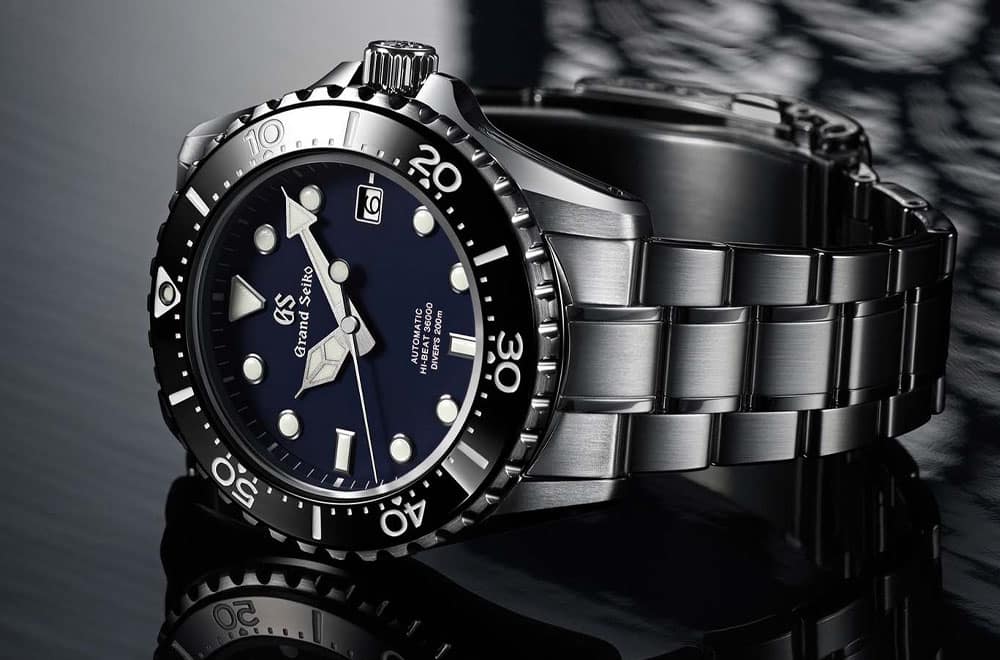Introduction
Rolex and Doxa first presented the helium escape valve in the 1960s in response to the needs of professional divers operating under demanding underwater conditions. Often in scientific, military, or commercial spheres, these divers routinely work in surroundings rich in helium in decompression chambers. One of the smallest and lightest molecules, helium, can sneak into the watch via seals and gradually increase pressure. The watch crystal would finally be forced out without a mechanism releasing this trapped gas, therefore endangering the integrity of the clock.
The Helium Escape Valve’s Science

To understand the importance of managing gas diffusion under pressure, one must first grasp the science behind it. In order to reduce the risks of nitrogen narcosis and decompression sickness, divers often work in pressurized environments for extended periods, typically using a mix of helium and oxygen in saturation diving. This technique allows them to perform deep-sea tasks more safely, as the gas mixture and pressure levels help to prevent potentially dangerous nitrogen buildup in the body.
Helium is chosen since it is an inert, non-toxic gas that, under high pressure, does not produce the physiological problems related to nitrogen. But because helium atoms are tiny, they can pass through seals in high-quality diving watches—including those made especially to be waterproof. Helium molecules gather inside the watch case over time to generate internal pressure buildup.
The purpose of this mechanism is to balance internal pressure, allowing gas to escape before it can damage the watch. The mechanism activates to release the gas when internal case pressure exceeds a certain threshold, preventing the crystal from detaching due to excessive internal pressure. It then closes automatically once internal and external pressures are equalized, ensuring the watch remains water-resistant.
The Helium Escape Valve’s Mechanism
The two main forms of pressure release systems in watches are manual and automated. Though they operate slightly differently, each helps protect the watch from pressure buildup.
An automated pressure release system opens on its own when internal pressure reaches a specified level. This mechanism uses a spring-loaded design that responds to pressure changes. The spring contracts when internal pressure exceeds the pre-defined limit, opening the valve to release trapped gas. Once the pressure has equalized, the spring forces the valve back to its closed position, restoring the watch’s water resistance.
Conversely, the manual helium escape valve requires the operator to pull out or unscrew a designated crown on the watch to open it. This design lets the wearer regulate when and how the watch lets the trapped gas out. To manually control the valve at the proper moment, the diver must, nevertheless, be aware of pressure fluctuations and the surroundings of the watch. Although hand valves give more control, they are less handy for divers who can find it difficult to turn the valve at depth.
Why Do Only Some Dive Watches Include Helium Escape Valves?

Usually featured in upscale dive timepieces designed for harsh conditions and sold to professional divers, helium escape valves are usually not diving deep enough or staying submerged long enough to call for a decompression chamber, so recreational divers are unlikely to need this ability. Helium buildup mostly results from saturation diving, a technique employed in commercial diving when divers live in pressurized chambers filled with a helium-oxygen mix for protracted periods.
These divers stay in these chambers between dives and only decompress at the end of their assignment since, without decompression techniques in place, they run the danger of decompression sickness upon the surface. Recreational diving does not present this configuration.
Collectors and enthusiasts of luxury dive watches with helium escape valves are drawn not only to their practical worth but also to their engineering prowess and visual allure. These watches, sought after for their strength, durability, and ability to withstand the harshest underwater conditions, hold a unique fascination for divers and collectors alike.
Value Of Helium Escape Valves For Commercial Diving
For commercial divers, durability and reliability in a timepiece are essential. These professionals, who often work in pressurized underwater environments, depend on premium watches as core tools. A robust and well-engineered watch ensures it remains functional and easy to read, providing divers with the confidence they need to manage their dive duration and decompression schedules effectively.
With a high-performance watch, divers can boldly tackle demanding environments without the concern of frequent repairs or replacements. For commercial divers, a resilient and trustworthy timepiece is even more critical than their diving suit or oxygen tanks.
Standard Watches Featuring Helium Escape Valves
In the realm of professional diving watches, helium escape valves (HEVs) have become a hallmark feature for those who venture into extreme underwater depths. While standard watches offer excellent water resistance for everyday use, those equipped with helium escape valves cater specifically to saturation divers, who spend prolonged periods in pressurized environments, such as diving bells and underwater habitats. Understanding the significance and operation of these valves sheds light on how they differentiate high-performance dive watches from more conventional models.
The Purpose and Mechanism of Helium Escape Valves
Helium escape valves were developed to address a critical problem encountered by professional divers during deep-sea dives. In saturation diving, divers are exposed to breathing gas mixtures that often include helium due to its small atomic size, which minimizes narcosis and other deep-diving complications. Helium molecules are so small that they can penetrate seals and enter a watch case under pressure. During decompression, as pressure reduces, trapped helium can expand rapidly, potentially causing the watch crystal to pop off or the case to become damaged. The helium escape valve serves as a pressure release mechanism that allows helium gas to safely escape the watch case, preventing such catastrophic failure.
Typically, there are two types of helium escape valves found on diving watches: manual and automatic. The manual version requires the wearer to unscrew and open the valve before decompression, allowing the trapped gas to escape. The automatic valve, in contrast, releases gas pressure as it builds up, without any intervention from the wearer. This added layer of protection makes helium escape valves invaluable for saturation divers who rely on their watches for timing and safety.
Standard Watches with Helium Escape Valves
Prominent watch brands have developed diving watches featuring helium escape valves to cater to the demands of both professional divers and enthusiasts. Among these brands, Rolex, Omega, and Seiko have made notable contributions by incorporating this critical technology into their models.
The Rolex Sea-Dweller, for example, was one of the first watches to incorporate an automatic helium escape valve, introduced in the late 1960s in collaboration with Comex (Compagnie Maritime d’Expertises). It was specifically designed to endure the high pressures encountered by saturation divers. Modern iterations of the Sea-Dweller, including the Sea-Dweller 4000 and the Deepsea, continue to embody this legacy, offering exceptional water resistance and helium management capabilities.
Omega’s Seamaster Planet Ocean series is another example of a standard watch equipped with a helium escape valve. Known for its impressive water resistance and robust build quality, these watches are frequently chosen by professional divers and underwater explorers. The helium escape valve is located at the 10 o’clock position, providing easy accessibility and reliable protection against pressure buildup during decompression.
Seiko’s Marinemaster is yet another standard diving watch that incorporates a helium escape valve. While Seiko’s reputation for creating high-quality, reliable dive watches is well-established, models featuring this valve cater to professional use, offering reliability and precision at extreme depths.
Practicality and Appeal of Helium Escape Valves
While helium escape valves serve a critical function for saturation divers, they also appeal to watch enthusiasts who appreciate high-performance engineering and the legacy of professional tool watches. Though not strictly necessary for most casual divers or everyday wear, the presence of an HEV represents the pinnacle of dive watch innovation, durability, and capability. It underscores the watchmaker’s commitment to precision and rugged performance under extreme conditions. Watches with helium escape valves embody the spirit of exploration, making them prized by collectors and professionals alike for their blend of functionality, history, and technical excellence.
Can One Use A Watch Featuring A Helium Escape Valve For Outside Diving?

One common question is whether a watch with enhanced dive features can be worn in normal, non-pressurized environments. The answer is a resounding yes. These specialized features are only utilized in extreme circumstances, such as deep-sea or saturation diving. In everyday situations, the watch functions like any other premium timepiece, allowing users to wear it comfortably without any issues.
In fact, many users of a dive watch with advanced capabilities may never engage these extreme features since they are only active in rare, intense diving conditions. The presence of these design elements doesn’t interfere with routine activities; rather, it can even become a conversation starter for those intrigued by its technical design. Even if not used for professional diving, the durability and unique aesthetic of these watches make them popular among both divers and watch enthusiasts.
Conclusion
The helium escape valve is evidence of the watchmakers’ inventiveness and their capacity to design timepieces resistant to the hostile underwater environment. It’s a great advantage for professionals in saturation diving since it shields their timepieces from helium buildup during decompression. Though most recreational divers or regular users may not need this function, it is nonetheless a highly appreciated quality of luxury dive timepieces that attracts collectors as well as divers for its dependability and resilience.
Frequently Asked Questions
Could I Dive Using A Watch Without A Helium Escape Valve?
Yes, as long as you are diving rarely. Helium escape valves are mostly required for saturation diving, in which the watch spends a long time in surroundings rich in helium. Standard dive watches without helium escape valves are plenty for leisure diving.
How Can I Find Out Whether The Helium Escape Valve On My Watch Is Automated Or Manual?
Most manufacturers indicate in the manual or product description the kind of helium escape valve their dive watches feature. While manual valves contain a separate crown or push button that must be used manually, timepieces with automatic helium escape valves generally do not require user interaction.
Does A Dive Watch Absolutely Need A Helium Escape Valve?
Indeed, skilled saturation divers should take great care to avoid helium buildup, which can cause damage. On the other hand, the helium escape valve is optional for recreational divers or people who do not dive and offers more longevity but is not absolutely required.
Can A Helium Escape Valve Malfunction Or Break?
Although unusual, a malfunction in a helium escape valve could be especially caused by damage or clogging. A professional watchmaker’s regular maintenance and servicing guarantee proper valve performance over time.
Does The Compromise Of The Water Resistance Of The Watch By The Helium Escape Valve?
Actually, by stopping harm caused by internal pressure buildup, the helium escape valve increases the lifetime of the watch. When correctly built and maintained, the watch’s water resistance is not changed by the helium escape valve.






